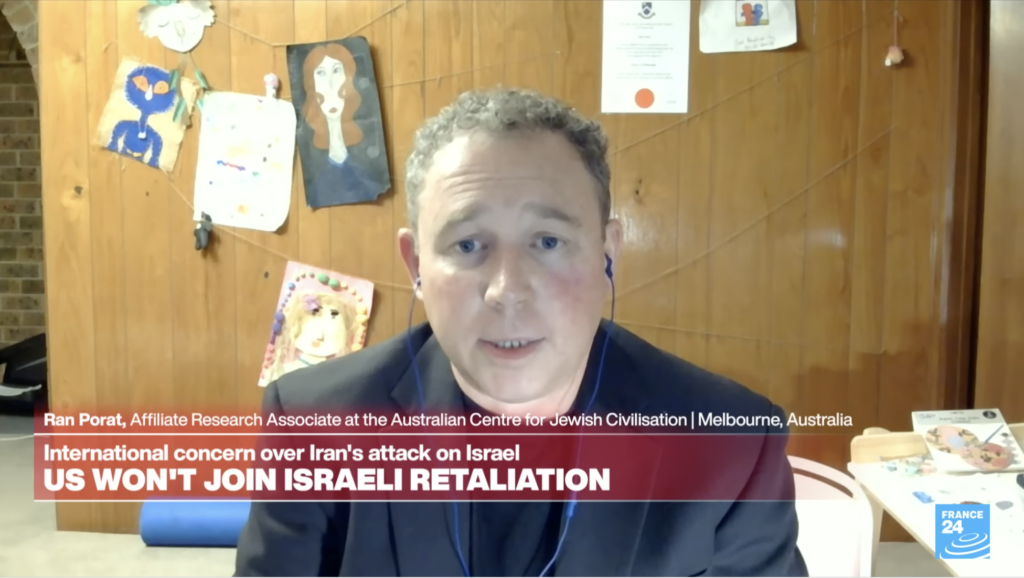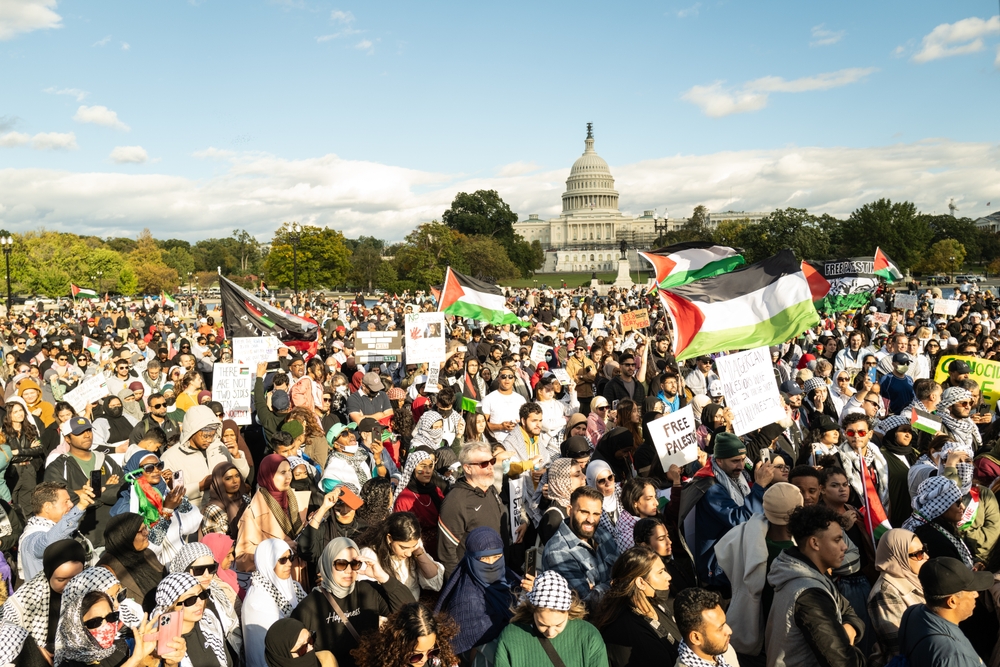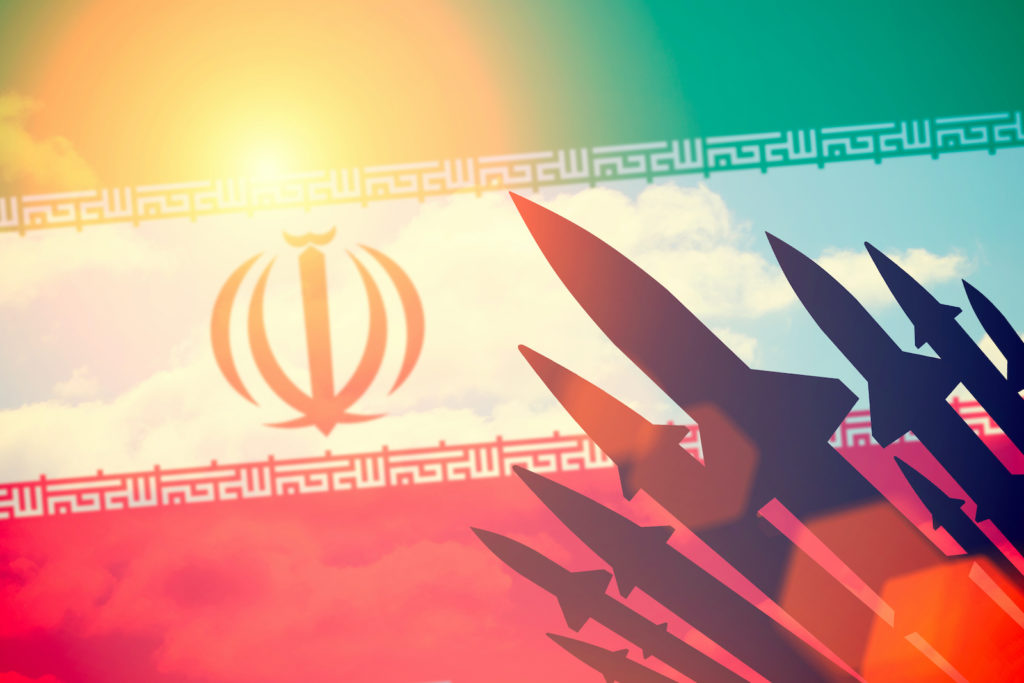UPDATES
The Killing of Imad Mugniyah
Feb 14, 2008 | AIJAC staff
Update from AIJAC
February 14, 2008
Number 02/08 #06
As readers will probably be aware from the news, yesterday in Damascus a bomb in his car reportedly killed Imad Mugniyah, the Hezbollah chief of operations and a near legendary terrorist mastermind. This Update looks at who Mugniyah was, and the significance of his killing.
First up, putting Mugniyah and his assassination in broad perspective is Dr. Boaz Ganor, director of the International Centre for Counter-Terrorism in Herzliya, Israel. Ganor discusses how central Mugniyah was to all Hezbollah terrorist operations over decades, but also the crucial role he played standing at the heart of the Iran-Syria-Hezbollah terrorist relationship. Ganor also looks at who might be responsible for the bomb that killed Mugniyah, as well as the strong likelihood of Hezbollah attempts to retaliate against Jewish or Israeli targets, regardless of whether or not Israel was actually responsible for the bombing. Read all his comments, HERE. Additional analysis of the significance of Muniyah’s removal from the scene comes from American scholar Michael Ledeen, Washington Institute Syria specialist David Schenker, Israeli columnist Calev Ben-David, a Jerusalem Post editorial, Haaretz journalists Yossi Melman and Amir Oren and Middle East reporter Bill Roggio. Additional comment on the prospects of retaliation comes from Israeli security analyst Ron Ben-Yishai.
Next up is a good summary of Mugniyah’s terrorist career from Jerusalem Post journalists Yaakoz Katz and Khaled Abu Toameh. They point out that Mugniyah was a Palestinian Sunni who got his start in Force 17, part of the PLO, in the 1970s, became a pioneer in the use of suicide bombings as part of Hezbollah, and reportedly developed important ties with al-Qaeda. He was also a central player in the Iranian Revolutionary Guards, and responsible for dozens of terror attacks. For a more detailed summary of this highly violent career, CLICK HERE. Additional partial summaries of past terror acts attributed to Mugniyah are here and here. More details on Mugniyah’s alleged al-Qaeda relationship are here. Finally, Amir Oren of Haaretz comments that Mugniyah is a good illustration that, in a terror war, not everyone is replaceable.
Lastly, a number of Israeli experts expand on the significance of Mugniyah’s career and death, including former Mossad head Danny Yatom and terrorism specialist Yoram Schweitzer. Yatom calls him “one of the most dangerous terrorists ever” while Schweitzer says his importance to Hezbollah was comparable to that of its leader, Sheikh Hassan Nasrallah. There are also several quotes from anonymous sources in Israeli military intelligence. For all these various assessments, CLICK HERE. Also, comments from some Arab analysts are reported here.
Readers may also be interested in:
- Hezbollah and Syria are both accusing Israel of being behind the killing of Mugniyah, but Israeli Prime Minister Olmert’s office has denied responsibility. Meanwhile, Hamas used the occasion to throw around language about the “Zionist octopus” and “Zionist gangsterism” while Iran says Mugniyah’s death will only bring an “earthquake” against the “Zionist regime.”
- Some speculation on who might be responsible for the bomb attack on Mugniyah here and here.
- Iran specialist Meir Javedanfar comments on how the killing will affect Iran’s intelligence network, with whom Mugniyah worked very intimately.
- As background, a good but less recent article on how Hezbollah makes decisions and Mugniyah’s role in that process.
- Syria again jails its leading dissident, Riad Seif, who is ailing and very likely to die in prison.
- Hezbollah has reportedly begun placing large numbers of rockets into Southern Lebanon in violation of the UN resolutions that ended the war in 2006.
- The Iraqi parliament passed three watershed pieces of legislation crucial to national reconciliation. A good comment on the significance of these laws is here.
Analysis: The man linking Iran, Syria and Hizbullah
By DR. BOAZ GANOR
Jerusalem Post, Feb 13, 2008
It’s hard to imagine a figure more dangerous, more sophisticated or more experienced than arch-terrorist Imad Mughniyeh. Until his assassination on Wednesday, Mughniyeh served as the mastermind behind Hizbullah’s operations, an elusive figure linked to almost every attack executed by the organization since its inception in the early 1980s.
In fact, it is impossible to name even one large-scale attack executed by Hizbullah that Mughniyeh was not involved in – from airplane hijackings to embassy bombings to kidnappings and more.
The senior Hizbullah leader was responsible for suicide attacks on the American embassy and Marine barracks in Beirut in 1983, which lead to the strategic withdrawal of American and foreign forces out of Lebanon. He was also wanted in connection to the 1992 bombing of the Israeli embassy and the 1994 attack on the AMIA building in Buenos Aires, attempted attacks in Asia and the Arab world and the kidnappings of dozens of Westerners in Lebanon throughout the 1980s.
Mughniyeh’s importance lies not only in his ability to execute extraordinary attacks against targets around the world – or even in his control of Hizbullah’s operational branch in Lebanon – but more significantly in the close connections he established between Iran, Syria and Hizbullah. Mughniyeh positioned himself as the operational link between these actors. It is in this framework that Mughniyeh also served as al-Qaida’s contact within Hizbullah throughout the 1990s.
There is good reason the FBI set a $5 million price on his head, and that some in the American intelligence community have described Mughniyeh as an even more dangerous enemy than Osama bin Laden himself.
Unlike bin Laden, however, Mughniyeh’s influence was not derived from the image he created of himself, but by his actual deeds and capabilities as an initiator, planner, supervisor and executor of attacks on an international scale. In effect, these attacks tremendously strengthened Hizbullah’s capabilities in a variety of spheres, creating the deterrence that the organization was seeking to achieve vis-à-vis foreign states and Israel.
After the assassination of a terrorist leader – especially one as senior as Mughniyeh – the question arises: Will there be a boomerang effect? Will the organization seek retaliation? Hizbullah is known to employ a policy – developed by Mughniyeh himself – in which a significant attack against the organization and its leaders does not pass without harsh response. It is thus reasonable to assume that such retaliation will indeed follow Wednesday’s assassination.
The list of actors potentially responsible for Mughniyeh’s assassination is long and goes well beyond Israel. Among the possible culprits: Lebanese Christians who hold Mughniyeh responsible for assassinations against their own leaders; competing factions within the Shi’ite community; and Syrian intelligence figures who, despite previous cooperation, may have been uncomfortable with Mughniyeh’s close connections to Iran and his strength within Lebanon and the Mediterranean region.
Yet there is actually little importance in identifying the perpetrators.
Even if Israel is relieved of responsibility for the assassination, Hizbullah will react instinctively against Israel – placing blame on the country and even retaliating with attacks against Israeli targets and interests around the world.
Hizbullah, under Mughniyeh’s leadership, has already developed the infrastructure and contingency plans necessary to activate sleeper cells into launching attacks against Jewish and Western interests on short notice – a matter of days, weeks or months. They are additionally capable, of course, of launching Katyusha rocket attacks against Israel from Lebanon.
Hizbullah retaliated against Israeli and Jewish targets in Argentina after the Israeli assassination of organization leader Abbas al-Musawi in 1992 and Israel Air Force bombings in 1993.
While Mughniyeh’s assassination may serve to intensify the group’s motivation to fulfill their proven capabilities, the hand that controlled the organization’s activities for so long, which previously would have been the hand of retaliation, has now been severed.
Dr. Boaz Ganor is the Executive Director of the International Institute of Counter Terrorism (ICT) and the Deputy Dean of the Lauder School of Government at IDC Herzliya.
Back to Top
————————————————————————
Mughniyeh co-founded Hizbullah’
YAAKOV KATZ and KHALED ABU TOAMEH ,
THE JERUSALEM POST Feb. 13, 2008
For 25 years, Hizbullah operations chief Imad Mughniyeh was one of the world’s most wanted terrorists, involved in endless attacks against Israel and the United States, including the abduction of two IDF reservists in 2006 and the bombing of US embassies in Africa.
Less known than Osama bin Laden but considered a greater outlaw, Mughniyeh was implicated in the 1983 bombing of the US Embassy and Marine barracks in Beirut that killed more than 300, as well as the 1994 bombing of the Israelite Mutual Association building in Buenos Aires, which killed 85 people, and the 1992 attack on the Israeli Embassy in the same city, in which 29 died.
He apparently had strong ties with al-Qaida, and according to the testimony of Ali Muhammad – a senior al-Qaida operative who was arrested for involvement in the attacks on American embassies in Africa – Mughniyeh met with bin Laden in Sudan in 1993. Hizbullah, Muhammad said, provided explosives training for al-Qaida fighters. This relationship – and the fact that Mughniyeh was Hizbullah’s liaison to al-Qaida – has led Western intelligence agencies to raise the possibility that he was also involved in the September 11 attacks.
Born in Tyre, Lebanon, in 1962, Mughniyeh did not attract attention until 1976, when he joined the PLO’s Force 17 as a sniper targeting Christians on the Green Line dividing West and East Beirut.
Fatah officials told The Jerusalem Post that he had been very close to Yasser Arafat when the PLO was based in Beirut.
“His nickname was tha’lab [the fox], and today he’s considered the second most important figure in Hizbullah after Secretary-General Sheikh Hassan Nasrallah. We’re very proud to have had a Palestinian holding such a high position in Hizbullah,” said a Fatah official who said he had known Mughniyeh well during the ’70s and ’80s.
When the IDF forced the PLO to leave Lebanon in 1982, Arafat entrusted Mughniyeh with transferring the organization’s weapons to Lebanese armed groups allied with the Palestinians. Mughniyeh, who refused to leave Beirut with the PLO leadership, joined the the Shi’ite Amal militia headed by Nabih Berri. He and Nasrallah later left the movement to form Hizbullah.
The first terrorist attacks in which he was implicated were the 1983 bombings of the US Embassy and barracks housing US Marines and French paratroopers, who were part of the Multinational Force in Lebanon. Around 350 people were killed.
In 1985, Mughniyeh was believed to have been one of the terrorists who hijacked a TWA flight on its way from Athens to Rome. The plane was forced to land in Beirut and afterwards flew to Algeria before returning to Beirut. He was later indicted in the US for the murder of one of the hostages on board, a US Navy diver.
On October 10, 2001, Mughniyeh appeared on the FBI’s first “Top 22 Most Wanted Terrorists” list. A reward of $5 million was offered for information leading to his capture.
He has also been linked to the Karine A weapons ship that Arafat tried to use to smuggle arms into the Gaza Strip in 2001, as well as the kidnapping of three IDF soldiers in October 2000 by Hizbullah and the abduction of reservists Eldad Regev and Ehud Goldwasser in the summer of 2006.
Mughniyeh was Hizbullah’s chief liaison with the Iranian Revolutionary Guards and was believed to have spent most of his time in Teheran under tight Iranian security. Outside of Iran, he reportedly never slept in the same place twice and constantly looked over his shoulder.
In January 2006, Mughniyeh is believed to have traveled with Iranian President Mahmoud Ahmadinejad to Damascus for a meeting with Nasrallah, Hamas leader Khaled Mashaal and Islamic Jihad chief Ramadan Salah.
“He knew that he was on the FBI’s list for many years, and he has lived many years according to this understanding – and this was strengthened following the Second Lebanon War,” said Col. (res.) Dr. Eitan Azani, deputy executive director of the Institute for Counter-Terrorism at the IDC Herzliya and a former head of the Lebanese Desk at IDF Military Intelligence.
In contrast to bin Laden, Azani said, Mughniyeh “did not have a political role, but was strictly involved in operations, like the chief of General Staff.”
Back to Top
————————————————————————
Military Intelligence: Hizbullah lost its number one figure
Hanan Greenberg
Ynet.com, 02.13.08, 16:12 / Israel News
“Hizbullah lost its most important operative in the organization in recent years,” a reservist Military Intelligence officer told Ynet on Wednesday in reference to the killing of senior Hizbullah military commander Imad Mugniyah in an explosion in Damascus.
“He was an expert in carrying out terrorist attacks and at the same time, he was an expert in maintaining a low profile and knowing, for 20 years, how to evade the many that tried to get him,” the reservist officer added.
Senior IDF officers that served in Military Intelligence had a hard time hiding their satisfaction about the news that came in from Damascus – Mugniyah is no longer walking this earth. All were quick to point out that they were not familiar with the incident itself and that they were not inferring that Israel was responsible.
“He was wanted in many countries for many years so many people were trying to kill him,” one of the officers said. “After every significant incident with Hizbullah, his name came up as the person that planned it or the creative head (behind the incident).
“There is no doubt that he was a significant force behind actions against Israel and his name was mentioned many times – also during the Second Lebanon War – primarily connected to the kidnapping of the two reservist soldiers,” the officer added.
Military Intelligence and other national security organizations do not hide the fact that various attempts were made to track Mugniyah’s path. However, it appears that the arch-terrorist was well aware of his “popularity” in Israel and succeeded in using the strict compartmentalization of information among his associates to maintain a low profile.
‘As important as Nasrallah’
Yoram Schweitzer, a senior research fellow at Israel’s Institute for National Security Studies (INSS), believes that Mugniyah’s significance within Hizbullah was close to that of Secretary-General Hassan Nasrallah’s.
“Although Nasrallah is the leadership figure, political and very capable, and even though Mugniyah was an operational figure, he led tens of special missions and we shouldn’t underestimate his position,” Schweitzer said in a conversation with Ynet.
According to Schweitzer, Mugniyah appointed successors to take his pace in the future and thus his disappearance from the world won’t leave his spot open for long. However, Schweitzer was quick to point out that the terrorist mastermind was a central Hizbullah figure responsible for a long list of terrorist attacks and his elimination was a major accomplishment.
MK Danny Yatom (Labor), who served as Mossad chief in the 90s, said that “Mugniyah was one of the most dangerous terrorist ever. He operated in complete secrecy and concealed his every action. He made sure that there was a high degree of compartmentalization around him.
“This was also the reason that it was hard to locate him…Mugniyah operated with full cooperation with Iranian intelligence. He was a very clever man,” Yatom said.
Amnon Meranda contributed to this report











